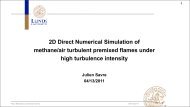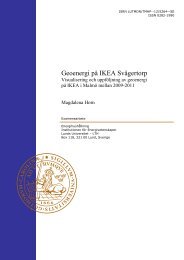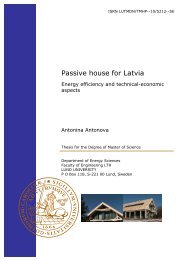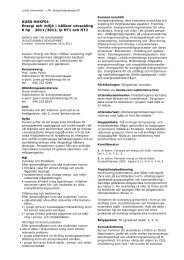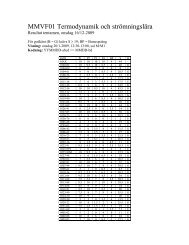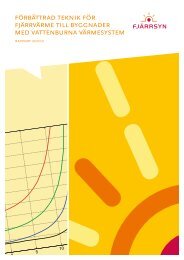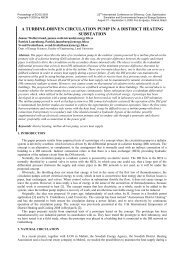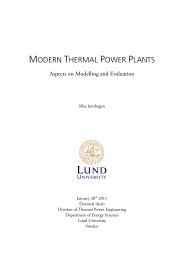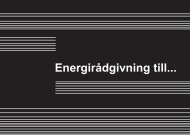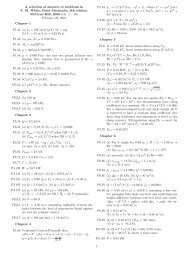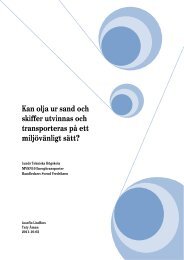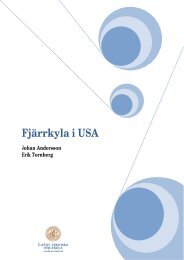Energy Consumption in Tertiary Buildings in Sweden - Case-study
Energy Consumption in Tertiary Buildings in Sweden - Case-study
Energy Consumption in Tertiary Buildings in Sweden - Case-study
You also want an ePaper? Increase the reach of your titles
YUMPU automatically turns print PDFs into web optimized ePapers that Google loves.
CASE-STUDY: M-build<strong>in</strong>g at Lund University - LTH<br />
Akademiska Hus<br />
Akademiska Hus is the company that owns M-build<strong>in</strong>g and therefore is<br />
responsible for build<strong>in</strong>g’s energy management. This company is owned by the Swedish<br />
government and is one of the largest property companies <strong>in</strong> <strong>Sweden</strong> with more than<br />
3.2 million square meters. The ma<strong>in</strong> bus<strong>in</strong>ess of AH is leas<strong>in</strong>g their properties to<br />
educational and research <strong>in</strong>stitutions. With a 64% of the market share is the ma<strong>in</strong><br />
provider of premises to colleges and universities. Teach<strong>in</strong>g and laboratory premises<br />
are the largest proportion of floor space with and 82% of the total surface (Akademiska<br />
Hus 2010a).<br />
The assessed market value of their properties was 49497 MSEK <strong>in</strong> 2010, more<br />
than 535 M€. The rental revenue was 4983 MSEK, around 540 M€, and the net<br />
operat<strong>in</strong>g profit was 3134 MSEK 340 M€ approximately (Akademiska Hus 2010a).<br />
In terms of energy the total consumption of build<strong>in</strong>gs owned by AH was more<br />
than 900 GWh per year <strong>in</strong> 2010. This is around the 1.89% of the total energy<br />
consumption <strong>in</strong> the services sector <strong>in</strong> <strong>Sweden</strong>. Of this 900 GWh per year more than<br />
400 GWh where used as electricity, around 400 GWh as heat<strong>in</strong>g and approximately 70<br />
GWh <strong>in</strong> cool<strong>in</strong>g systems. Per square meter, the total energy use was 241 kWh/m 2 , 112<br />
kWh/m 2 <strong>in</strong> electricity, 110 kWh/m 2 <strong>in</strong> heat<strong>in</strong>g and around 19 kWh/m 2 <strong>in</strong> cool<strong>in</strong>g<br />
systems (Akademiska Hus 2010b).<br />
<strong>Energy</strong> and water supply expenditure were 650 MSEK <strong>in</strong> 2010, this was 69% of<br />
the total operat<strong>in</strong>g cost of the company. This is an average of 203 SEK/m 2 per year.<br />
Figure 5 shows the distribution per f<strong>in</strong>al use. The ma<strong>in</strong> part of the energy cost is due to<br />
electricity consumption, about 390 MSEK. Heat<strong>in</strong>g costs were 217 MSEK while cool<strong>in</strong>g<br />
costs were 20 M SEK (Akademiska Hus 2010a).<br />
60,0% 33,4% 3,1%<br />
4,2%<br />
0,0% 10,0% 20,0% 30,0% 40,0% 50,0% 60,0% 70,0% 80,0% 90,0% 100,0%<br />
Electricity Heat<strong>in</strong>g Cool<strong>in</strong>g Water supply<br />
Figure 5: Energetic and water supply costs distribution. Source AH, 2010b<br />
10



